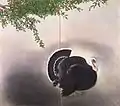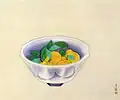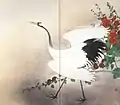Kokei Kobayashi | |
|---|---|
 circa 1953 | |
| Born | Shigeru Kobayashi February 11, 1883 Takada, Niigata Prefecture, Japan |
| Died | April 3, 1957 (aged 74) |
| Nationality | Japanese |
| Education | Kajita, Hanko |
| Known for | Painter |
| Movement | Nihonga |
| Awards | Order of Culture(1950), Person of Cultural Merit(1951) |
Kokei Kobayashi (小林古径, Kobayashi Kokei, February, 11, 1883 – March, 3, 1957) was a Japanese Nihonga painter.[1]
Biography
He became an orphan early in his life, at the age of 17 he moved to Tokyo and studied traditional Japanese painting at Kajita Hanko.[2] Later he became on of the most notable members in the Restored Japan Academy of Art. [3]
Initially, he painted traditional subject matter ("Taketori monogatari"-1914 as an example) but later he continued with still life and contemporary scenes. His famous works include: "Amida-dō" (1914), "Ideyu" (1918) and "Kami" (1931). [3]
He was friends with Tamako Kataoka (1905–2008).
He was awarded the Order of Culture.
Works
 Fruit (1910)
Fruit (1910) In the Bath (1918)
In the Bath (1918) Magnolia Tree (1919)
Magnolia Tree (1919).jpg.webp) Hair (Unknown Date)
Hair (Unknown Date) Turkey (1928)
Turkey (1928) White flowers and bird (1930s)
White flowers and bird (1930s) "Cherry Blossom" (1930s)
"Cherry Blossom" (1930s) Crane (1928)
Crane (1928)
See also
- Seison Maeda (1885–1977), one of the leading Nihonga painters
- List of Nihonga painters
References
- ↑ "Kobayashi Kokei | Japanese painter".
- ↑ "梶田半古(かじた・はんこ)とは? 意味や使い方". コトバンク (in Japanese). Retrieved 2023-04-22.
- 1 2 "Kobayashi Kokei | Ukiyo-e, Woodblock Prints, Landscapes | Britannica". www.britannica.com. Retrieved 2023-12-21.
External links
Wikimedia Commons has media related to Kobayashi Kokei.
This article is issued from Wikipedia. The text is licensed under Creative Commons - Attribution - Sharealike. Additional terms may apply for the media files.